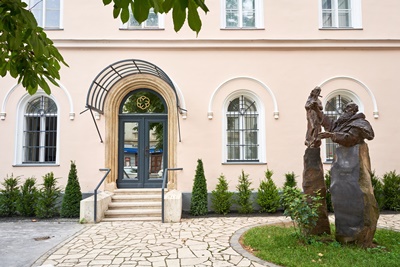Little bit of history
In 1209, the Pope orally approved the rules of life of Francis of Assisi and the dozen men who joined him, and gave them the name Fraters Minores, or Minor Brothers. This date, 1209, is considered the date of the foundation of the Franciscan Order.
In 1525, Matteo Bascio, a simple Franciscan friar, decided to follow the example of Saint Francis in the smallest details. Brother Matteo went on a pilgrimage to Rome, where, at his request, Pope Clement VII laid down the legal foundations of the new Order in a bull in 1528. He allowed Matteo and his followers to keep the Franciscan Rule literally and to preach penance. They reverted to beards, wearing coarse tunics with pointed hoods. The name Capuchin is derived from the name of this hood, but it was not given until 1534. After a century, there were nearly 17,000 Capuchin monks in 1,260 monasteries in 42 provinces of the Capuchin order in Europe.
Following the establishment of the Capuchin order, Capuchin monks appeared in Hungary as early as the end of the 16th century as chaplains to the papal armies fighting the Turks in the war. We meet them in 1595 at the siege of Esztergom, in 1597 at the Battle of Vác, in 1601 at the siege of Kanizsa, and in 1601 under the leadership of St. Lawrence of Brindisi at the Battle of Kusa.
Mark of Avignon (1631-1699), Italian Capuchin monk and chaplain, was instrumental in organising the liberation campaign against the Turks. His activities made the Capuchin order popular and famous in Hungary. Many people believed that the Capuchins, with the spirit of St. Francis, could be a powerful factor in the reconstruction of Hungary after the Turkish rule, in the consolidation of our country and in the uplifting of the poor people. This was the thinking of György Széchényi (1605/1606-1695), Archbishop of Esztergom, Prince Primate, who asked the Pope and the universal head of the Capuchin Order for Capuchins and made a donation to the Capuchin Order, founding the Capuchin monastery in Buda.
But what happened to the monks who worked here? The community of about 10 people remain in the smaller wing of the T-shaped complex, and when you look up from the hotel breakfast room, for example, you can see their windows, and if the monks look out, they can see hotel guests having their first meal of the day. Although the two wings are closed off from each other, they are both owned by the Order, from whom the hotel owners rent the hotel part.
History of the hotel building
The renovation of the 30 0-year-old Baroque-style abbey building began in 2016, based on plans by Kima Studio, while retaining elements of the original building for both heritage and conceptual reasons. The original demolished walls can be seen in places, the old staircase and external window frames are original, and there are parts where the corridor with its original marble floors, snow-white walls and arches looks like a real monastery, especially with its dark-toned room doors.
0-year-old Baroque-style abbey building began in 2016, based on plans by Kima Studio, while retaining elements of the original building for both heritage and conceptual reasons. The original demolished walls can be seen in places, the old staircase and external window frames are original, and there are parts where the corridor with its original marble floors, snow-white walls and arches looks like a real monastery, especially with its dark-toned room doors.
The two floors have a total of 47 rooms, designed in green on the ground floor, blue on the first floor and red on the third. Standard rooms, Superior rooms, Family rooms and the Executive Suite (45 square metres - created on the site of the former school's banqueting hall) make up the total room capacity. They all have a clean, minimalist style, with some original walls still visible, while the round floral motif, a sign of order, is found in several places throughout the hotel, including on the glass windows of the showers. It is also the logo of the Monastery Boutique Hotel and can be seen on the original façade of the building and on the roof of the monks' wing. Old photographs of the monastery are also on display when you enter the lift, for example, a 1928 enlargement of a Capuchin priestly ordination on the ground floor.
